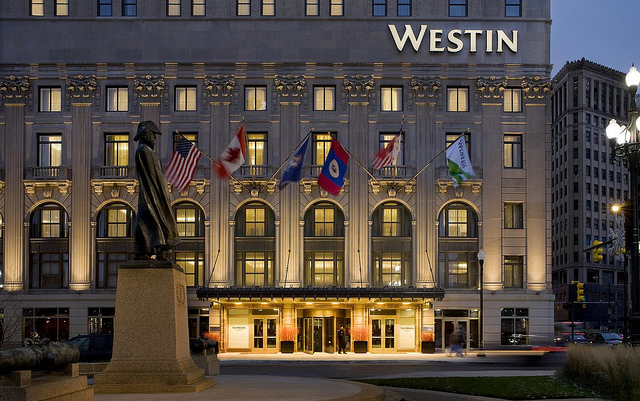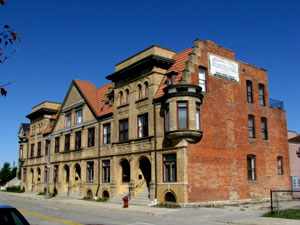Jeanette wanted to introduce me to an innovative use of some of this vacant urban land. Next to the Gleaner Community Food Bank is a community garden that uses empty green spaces for urban agriculture. The Gleaner Community Food Bank helps to feed hungry citizens, and some of the fresh vegetables and fruits come from the community garden that is located right across from the warehouse.
Our next stop focused on a really unusual space: the Heidelberg project, an outdoor art installation in an African-American neighbourhood on Detroit’s east side.

Artist Tyree Guyton (right) with Jeanette and an out-of-town visitor
This extraordinary environment includes an entire city block as well as several houses and integrates bright paint colours and a large collection of found discarded objects. Creator Tyreee Guyton grew up on Heidelberg Street and was displeased with the deterioration in his neighbourhood. As a form of social protest he painted his grandfather’s house with bright polka dots and created the now famous “Dotty-Wotty House” in 1986.

The famous “Dotty-Wotty House”
Together with his grandfather and his former wife, Tyree Guyton began to clean up the neighbourhood and transformed the refuse they collected into massive art installations. Since the beginnings many other houses and outdoor creations have followed. Even city-ordered demolitions in 1991 and 1999 could not stop the success of the Heidelberg Project. Creator Tyree Guyton has been featured on various television programs (including Oprah) and won numerous awards for his work.

Noah’s Ark
During our brief stroll on Heidelberg Street we saw a group of joggers come through as well as various international visitors from Toronto and Boston. Another example of creative use of space in Detroit, the Heidelberg Project today attracts around 275,000 visitors a year, and creator Tyree Guyton travels all over the world giving presentations about this project. We even ran into the artist himself who graciously talked to us and told us about the significance of this project which has transformed vacant lots into colourful and meaningful urban art.

More outdoor art on Heidelberg Street
After unsuccessfully trying to reach some friends of Jeanette’s, artists who live in a local loft, we briefly stopped at Detroit’s Eastern Market which truly comes to life on Saturday mornings. We stopped into the R. Hirt Jr. store which features cheeses and delicacies from all over the world. Market activities have been taking place here since the mid 1800s and the sales sheds seen today date back to 1891. Detroit’s Eastern Market is the largest historic public market district in the United States.

Buildings surrounding the Eastern Market
From here we drove north through Midtown Detroit, also referred to as Detroit’s Cultural Centre which is anchored by Wayne State University, the Detroit Institute of Arts, the Detroit Public Library, the Detroit Science Center, the Detroit Historical Museum, the Museum of African American History as well as the Max M. Fisher Music Centre. We stopped in at the Bureau of Urban Living, a hip local urban general store. Right next door are the Motor City Brewing Works, a microbrewery with a bar and an upstairs deck. Jeanette successfully demonstrated that Detroit is a hotbed of young urban entrepreneurs who are taking opportunity by the horns.

Jeanette in the Bureau of Urban Living
Further north we visited the area of New Centre whose main highlight is the historic Fisher building, an ornate 1928 skyscraper and Art Deco jewel designed by renowned Detroit architect Albert Kahn. The structure was originally designed for the Fisher Body Company which had become General Motors’ in-house coachbuilding division in 1926. Forty different kinds of marble decorate the lavish three-story barrel vaulted lobby which today holds a shopping concourse with various cool stores and cafes. The Fisher Theatre, with its lavish Aztec-style interior, is a popular destination among theatre lovers.

The stunning Art Deco lobby of the Fisher Building
Then Jeanette took me across the street to Cadillac Place, another stunning example of 1920s architecture. Designed by Albert Kahn in 1923, it was the second largest office building in the world. It was the headquarters of General Motors from 1923 to 1996 when GM moved to the Renaissance Centre downtown. This ornate high-rise office building features 31 elevators and has been a designated National Historic Landmark since 1978.

Lobby of Cadillac Place
After this extensive insider’s overview of Detroit our tour had come to an end I thanked Jeanette and dropped her off at the Detroit Welcome Centre. By now it was late afternoon and I had not had anything to eat since breakfast, so it was seriously time for an early dinner. I had wanted a waterfront dining experience and back home had already done some research into riverside dining options in Detroit. One place called “Sindbad’s at the River” had caught my attention since it was located right by the river and has been a family owned business for almost 60 years.

Getting ready to dine at Sinbad’s




